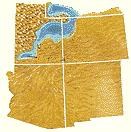
Brian Roanhorse/NPS 
Wikipedia The Three-Step Recipe to Create Bryce CanyonThe formation of Bryce Canyon and its hoodoos requires 3 steps: 1. Deposition of Rocks: Born in a Lake/Floodplain System 
2. Uplift of the Land: Plate Tectonics Creates an Uplifting Experience 3. Weathering and Erosion: The Sculpting of Hoodoos Weathering is the breaking down of rock and erosion is the transportation of that broken rock. These two forces of nature work in concert to sculpt Bryce Canyon’s hoodoos. The main natural forces of weathering and erosion that create the Hoodoos are ice and rain. 
Brian Roanhorse/NPS Part of the beauty of the hoodoos comes from their strange patterns. The shape of the hoodoos is attributed to slight variances in the material which comprises the rock. If you recall from the “deposition” section above, there are multiple types of rocks that make up Bryce Canyon. All of the rocks contain abundant calcium carbonate (CaCO3), a mineral that dissolves when it comes into contact with even slightly acidic water. When it rains at Bryce Canyon, the (slightly) acidic rain is enough to dissolve the calcium carbonate that holds these rocks together and allows them to erode into their current shape (and continues to shape them). When you look at the Hoodoos you will notice some layers that jut out, and some that indent inwards. This is a result of the rocks having varying amounts of calcium carbonate cementation and that controls how easily dissolvable (or how resistant) that rock layer is.Further Reading: Kiver, Eugene P., Harris, David V. 1999. Geology of U.S. Parklands 5th ed. John Wiley & Sons, Inc. 522-528. Sprinkel, Douglas A., Chidsey, Thomas C. Jr., Anderson, Paul B. 2000. Geology of Utah's Parks and Monuments. Publishers Press: 37-59 |
Last updated: September 4, 2021
